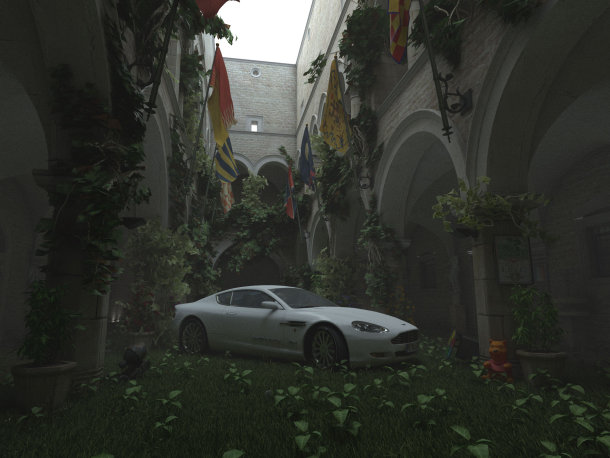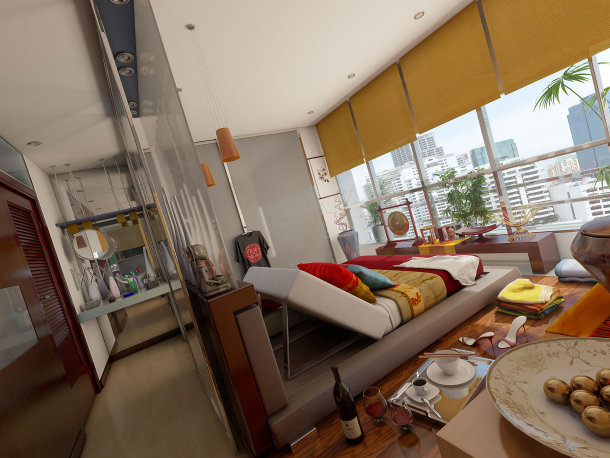Q&A: Alex Sandri, Maya/mental ray guru
 Alex Sandri is a freelance Maya and mental ray architectural visualisation artist, tutor and beta tester. He studied art at the Academy of Fine Arts and photography at the European Institute of Design in Milan and worked as a fashion photographer for several years. After a serious car accident enforced a change of careers, he taught himself Maya and mental ray.
Alex Sandri is a freelance Maya and mental ray architectural visualisation artist, tutor and beta tester. He studied art at the Academy of Fine Arts and photography at the European Institute of Design in Milan and worked as a fashion photographer for several years. After a serious car accident enforced a change of careers, he taught himself Maya and mental ray.
Now based in Bangkok, Thailand, he produces architectural visualisations for local and international real estate agencies, and has become one of the most prolific hunters – and killers – of bugs in the Maya/mental ray pipeline.
Alex recently recorded a seven-hour workshop on Environment Lighting and Progressive Rendering for the Gnomon School of Visual Effects’ upcoming series of online Master Classes, which go out from 11 to 25 February. We caught up with Alex from his holiday home in Koh Samui to find out what users can expect from it.
CG Channel: Tell us about the Master Class. What will you be covering?
Alex Sandri: Mainly the new environment lighting (IBL) and Progressive Rendering (PR) string options in mental ray 3.8, as well as the new iray rendering engine. The first two hours of the presentation are very descriptive, then the last five hours are give step-by-step instructions for Maya and mental ray.
The Master Class is based on the fifth part of a huge tutorial named ‘The Ultimate Maya & MR Archviz Guide’. It’s possibly the largest Maya/mental ray tutorial guide yet produced: it includes more than 900 pages of step-by-step instructions and over 1,000 screenshots. Even compressed, the project files come to over 4GB. I hope that The Gnomon Workshop will publish it early this year!
CGC: How long has it taken you to put together?
AS: When I started working on it, the current release was Maya 2009, so it’s taken me a long time – more than two years! I really hope it will be a turning point for learning mental ray for Maya.

One of Alex’s iray test renders. The scene, which is lit only by the HDR image, contains 30 million polys and took 10 hours to render. An occlusion pass has been layered on top, but no other retouching has been done in post.
CGC: What do you hope users will take away from the Master Class?
AS: First, I hope they will understand that in the past, there were far fewer learning resources for Maya and mental ray. As a self-taught artist and beta tester, it took me almost 10 years to improve my skills to this level. It was a long and painful process, and I don’t want other ‘green’ users to have to go through what I went through.
The second thing I’d like them to learn is how to customise mental ray using MEL scripting: for example, the IBL and PR string options. It’s very challenging. But once you get a hold on the techniques, they are very powerful.
And thirdly, I hope I have explained something that many 3D artists still find hard to understand: colour management, tone mapping and linear workflow. There’s still a lot of confusion about this important process.
CGC: What other tip would you give an aspiring lighting artist?
AS: I don’t know if I’d describe myself as a lighting artist. I do a bit of everything: I’m a kind of Maya generalist, although I mainly specialise in lighting, texturing and rendering.
But I just watched your interview with [Blur Studio’s] Alessandro Baldasseroni, and what he says is very correct: have a lot of curiosity. Look at everything around you: how it’s made, how light reflects and refracts from it, how it transmits the light.
I’m lucky that I used to be a fashion photographer, and the process is very similar to photography: it’s just that you have another dimension to work in.
CGC: 3D is a very competitive field. Why do you think you made it to the top?
AS: I’m really not sure I have reached the top yet. I’m not like most of the other famous artists recording these Master Classes: I haven’t worked in a big studio or in a big production pipeline, although I guess I’ve reached the peak of my knowledge.
Maybe I’ll reach the top eventually. I’m 44 now, so probably when I’m 70!

Keep dreaming and you’ll make it in the end, advises Alex – just cross your fingers that you don’t have to wait as long as this poor castaway!
CGC: Tell us something about your work that few other people know.
AS: I still consider myself a hobbyist – just maybe one of the most skilled Maya/mental ray hobbyists out there.
I spent long years beta testing Maya and mental ray in my spare time, trying to work things out by myself – and there were blackouts every two hours in Samui, where I was living, so you can imagine how often I had to restart the job when there was a ten-hour rendering going.
So I’d like to say to the guys out there: keep dreaming. Sooner or later, if you have the stamina and the patience, something will happen!
CGC: What part of the process makes you sit back and think: ‘This is why I do this job?’
AS: Probably when you render out a huge 200MB Maya scene and after several hours the resulting image is photorealistic as a real picture.
That, and when you find and solve new bugs and make Maya and mental ray work as expected. Before Maya 2009, when the integration was still super-buggy, a 200MB project could take a couple of months, because even if I found 10,000 bugs, I’d keep going until I’d solved them all.
But together with a bunch of Maya artists and programmers – I’d guess there aren’t more than a hundred of us in the world at this level – we made something happen. We made the implementation of mental ray in Maya become almost stable, so it can compete with the other high-end 3D applications.
CGC: So what do you hope your legacy will be in the industry?
AS: That instead of taking ten years to learn Maya and mental ray to this level, in future it will take maybe two years – three at most. If nobody else has to smoke tons of cigarettes while trying to figure it out how to work with the software, I’ve succeeded!
Visit the Gnomon School website to enrol for the Master Classes ($295 for all 12 classes)

